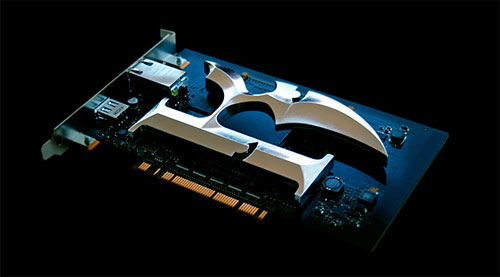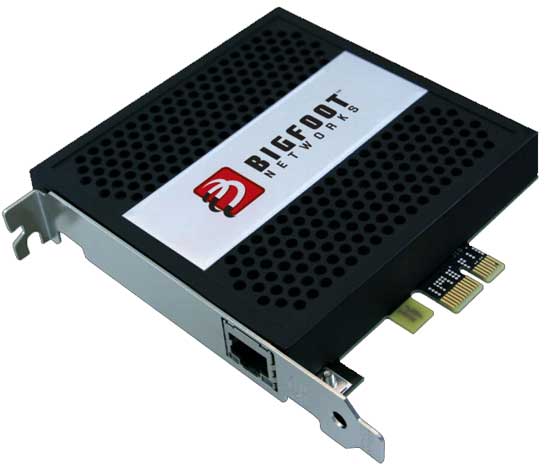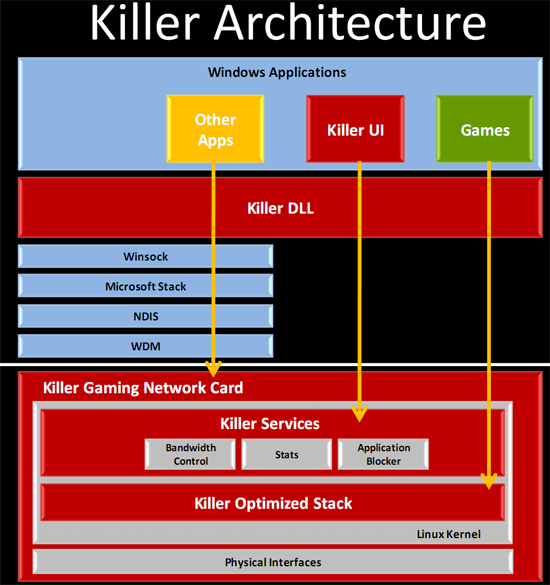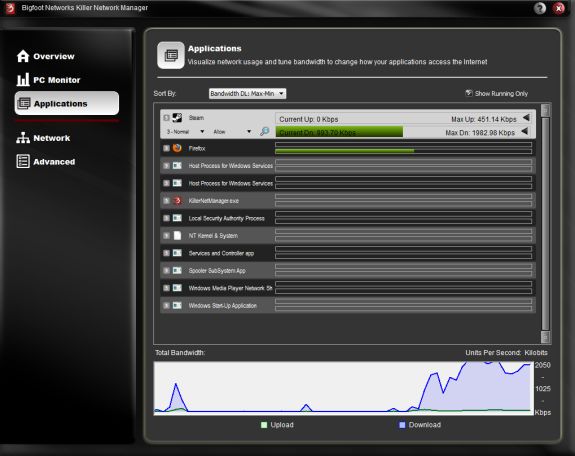Bigfoot Networks Announces 3rd Gen Killer NIC: Killer 2100
by Ryan Smith on May 11, 2010 12:01 AM EST- Posted in
- Networking
- Killer
- NIC
Back in 2006, technology newcomer Bigfoot Networks announced the Killer NIC, an unusual network interface card targeted at the high-end gaming market. With this coming fairly shortly after solid consumer-grade NICs became universally integrated in to motherboards, the timing wasn’t the best. At $280, neither was the price.
The Killer NIC marked a sort of return to the idea of a complex NIC, forgoing a simple controller/PHY combination in favor of a complex dedicated device capable of acting more independently. By endowing a NIC with a full-fledged microcomputer running Linux, not only could the card offload virtually every part of processing required for network operations, but it could even bypass Windows’ notorious networking stack and handle packets in a manner better suited for low-latency use (i.e. games). In turn the Killer NIC would be able offer lower and more stable pings than standard NICs, and with lower CPU overhead increase game/application performance too.

The original Killer NIC in 2006
The reality of the hardware didn’t quite live up to the initial hype. In our review of the original Killer NIC the results were a mixed bag: offloading did improve game performance slightly in CPU-limited situations, but we couldn’t find any significant improvements to ping/latency in games. Ultimately any benefits the card could offer couldn’t justify the $280 price tag even among the high-spending gaming crowd. Later in 2009 they released their second-generation Killer Xeno Pro, but even with a lower price the results were much of the same.
Flash forward to today and Bigfoot Networks has continued their product development unabated, bringing us to their latest product: the Killer 2100. The 2100 is Bigfoot’s 3rd generation Killer NIC, and will be replacing the Killer Xeno Pro. We will be reviewing the card next week when our sample arrives, but ahead of that we wanted to do a quick rundown of what we know thus far after talking to Bigfoot.

The Killer 2100
Let’s start with the hardware:
- 10/100/1000 Ethernet
- PCIe x1 interface
- 400MHz dedicated network processor (PowerPC)
- 128MB DDR2 RAM
Bigfoot tells us that the Killer 2100 hardware isn’t significantly different from the current Killer Xeno Pro. The biggest change is that Bigfoot has ditched all non-Ethernet functionality, dropping the USB port and the 3.5mm audio jacks, leaving only the RJ-45 port. Internally hardware is largely the same. The network processor continues to be an embedded PowerPC CPU, which was likely chosen for PowerPC’s big endian support.
As the hardware is being left relatively unchanged, the significant introduction for the Killer 2100 is the software stack, which Bigfoot is telling us had a major overhaul. As you may recall the entire Killer NIC line runs an embedded Linux distribution on the NIC, so in this case a software overhaul means upgrading both the embedded Linux distribution and the end-user Windows software.
Bigfoot hasn’t told us much about what they’ve done on the Linux side of things, although they are calling it a whole new architecture. In any case the fundamentals of the Killer NIC haven’t changed – it’s still based around bypassing the Windows networking stack on low-latency applications – with features such as application prioritization, offloading, and shaping/throttling bringing up the rear. The biggest low-level change we do know about is that Bigfoot has done something about the Killer Xeno Pro’s previously poor throughput, which means that the Killer 2100 should now be competitive at GigE speeds when operating on a LAN.

Beyond the usual optimizations, the bulk of the other changes are to the end-user software. Late last year Bigfoot introduced a new utility called Dashboard that augmented the Killer Xeno’s basic control panel with a more advanced graphical readout of the card’s status. The Killer 2100 is going to take this all the way, giving the Dashboard (now the Killer Network Manager) greater control over the card. This culminates in a new feature they are calling Visual Bandwidth Control, which in a nutshell is a graphical readout of each application’s bandwidth usage in order to see what each application is using and being able to set bandwidth throttles accordingly. Throttling itself isn’t new, but being able to visualize per-application usage from the NIC is, and is the cornerstone of what they’re calling their key breakthrough – allowing the user to better monitor the card.
Along with this, Bigfoot is also rolling out a new NIC benchmark they are calling Gaming Network Efficiency (GaNE). This is intended to solve one of Bigfoot’s biggest issues in selling the card – being able to showcase the difference in a reliable manner. Although we’re always leery of vendor-provided benchmarks, Bigfoot has offered us the source code to GaNE and we’ll be looking at it once our sample arrives to see if there’s anything to it.
GaNE also marks a bit of a shift in how Bigfoot will be marketing the Killer lineup. In their meeting with us, less of an emphasis was placed on total latency in favor of network jitter (which GaNE can conveniently benchmark). Bigfoot claims that the Killer 2100 has much less jitter than standard NICs, which would serve to keep latency more stable and avoid triggering undesired responses from games that believe that latency is spiking. Bigfoot still believes that the Killer 2100 will offer better latency through the combination of better jitter and their own optimizations towards latency by reducing buffering where applicable, but it’s certainly a more realistic approach than focusing solely on latency, something that’s largely out of the NIC’s hands in the first place. All of this we will of course be testing to see how truthful it is and what impact it actually has.
Finally, we’ll wrap up this announcement with some good news for existing Killer Xeno Pro owners. Since the hardware is largely unchanged, Bigfoot will be releasing a version of their new software stack for the Xeno Pro, giving it most of the functionality of the Killer 2100. Ultimately any future improvements to their software will be reserved for the Killer 2100, but this is an appropriate gesture given the short time of under a year between the launch of the Killer Xeno Pro and the Killer 2100.
The Killer 2100 will be selling at the same $129 price as the existing Killer Xeno Pro, cementing its spot as the Xeno Pro’s replacement. Bigfoot’s official press release leaves the actual availability date open with a simple “coming weeks”, although for North American distribution it sounds like it could show up as early as this week.
We’ll have more on the Killer 2100 in our full review next week, so stay tuned.











78 Comments
View All Comments
zzing123 - Tuesday, May 11, 2010 - link
IMO, Bigfoot are absolutely stark raving bonkers. The Killer NIC is effectively a computer on a chip that uses Linux to try and do a better job than Windows with accelerating TCP/IP. Instead of doing just that, Bigfoot could get a whole load of additional value from this Linux core, by using the lagg interfaces to manage a multi-port NIC, and also add a mini PCI slot or two on the card, and sell an array of mini PCI cards with a variety of Layer 7 acceleration coprocessors.Extremely low latency for games is one thing, but if I have a card that costs less than $300, has 4 ports, and accelerates OpenSSL using the 'engine' directive, or even offloading an entire OpenVPN connection on the card, then I'd buy it on the spot.
In the meantime, given that there's a $250 budget, I'd like to see how an Intel Pro/1000 Dual Port ET combined with a Netgear GS108T and a DD-WRT/Tomato firewall with QoS set up correctly will outpace a Killer NIC with no other hardware.
As such, when you test this can you test:
- Jumbo frames and Standard frame throughput
- Amount of SSL connections you can open against the test rig per second
- Throughput against similarly priced NIC's such as:
-- Intel Pro/1000 ET Dual Port Server Adapter
-- Intel Pro/1000 ET Quad Port Server Adapter
-- Intel Pro/1000 PT Server Adapter (Single port)
- Effect of traffic shaping behind a DD-WRT/Tomato router that is doing traffic shaping and a second test when it's not.
- On a modern server, also see if there's any virtualized offloading acceleration with ESX 4.0 as well
James5mith - Tuesday, May 11, 2010 - link
I still believe a good quality Intel Server Grade NIC will outperform this or any other "consumer" grade NIC.Not to mention a single port Intel Server NIC is only about $79.
BlueAqua - Tuesday, May 11, 2010 - link
If they release another network card that doesn't have gigabit lan then they are just sealing their own fate.Belard - Tuesday, May 11, 2010 - link
And what about the overhead for installing the required software to run the card on Windows?But according to 1 or 2 posters here, those who use torrents and gaming at the same time will the improvements. Guess that'll be a fairly rare customer who does that and has $250+ to blow.
Otherwise, from past reviews - no real world differences.
Check out the link (page 1 of responses) about making changes to how WinXP~Win7 does its networking to severely reduce lag. Thats is cleaner and costs nothing.
Arrakiv - Tuesday, May 11, 2010 - link
The overhead is pretty minimal at best, and much less than what you'll be saving with the card. We actually ran benchmarks with machines running the card + software vs machines without the software and card... While simulating some game network traffic while running the benchmarks, we found the killer-enabled machines gave consistently higher scores despite the overhead.I imagine that's something that'll pop up in the review over here, most likely.
jabber - Tuesday, May 11, 2010 - link
I just cant believe you guys are still in business. Any other product that gave as middling to none performance improvement over the years and from successive revisions would have gone under long ago.By all rights and logic you should have gone bust at least 3+ years ago.
Not funded by a Saudi prince with more money than sense are you?
AssBall - Tuesday, May 11, 2010 - link
I'll see what the review has to say before I pass that kind of judgement. That being said, the concept is still intriguing to me.HangFire - Tuesday, May 11, 2010 - link
The selling point of previous Killer cards was not reducing network latency, but Window's considerable network stack latency (and jitter), plus some rather interesting (but hard-to-prove) claims about reducing CPU overhead.However, Windows 7 has a greatly improved TCP/IP stack versus previous versions. Have these improvements reduced or eliminated the need for Killer's bypass stack implementation? If so it may have bypassed any possible need for the Killer card.
I hope AnandTech's upcoming review considers this question.
MustangMike - Tuesday, May 11, 2010 - link
I remember reading about the first Killer NIC, good concept still waiting practical use.Along with Windows 7 new network stack, maybe a benchmark showing multiple computer configurations.
Single or Dual Core CPU with 1GB or so of ram running Windows XP
And
Quad or new Phenom II X6 with 4-8GB of ram running Windows 7.
Might be a good way to see:
Old Generation computers vs New Generation computers
(I'm willing to bet that the old gen computers would show a
greater performance boost with Killer 2100 NIC then new gen computers.)
Windows Networking stack performance Win 7 vs Win XP
(Just curious if Win7 changes actually make any difference)
Killer 2100 NIC & in Single core
versus
Killer 2100 NIC & Multiple CPU cores
(Using idle cores to run "Networking Services and other Misc tasks" making Killer 2100 NIC useless.)
HangFire - Wednesday, May 12, 2010 - link
I like the suggestion of testing the new AMD hexa cores with virtual machines, which is one of the few justifications a home user could use for paying extra for one. Many software developers, software salesmen, and SysAdmins run such setups in order to test and learn without running a server farm.If the latest Killer NIC could deal with being hammered by requests from multiple VM clients better than a standard NIC, perhaps some cost justification could be found. Right now, I'm not ready to give up on my Intel gigabit cards.